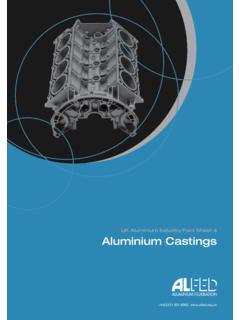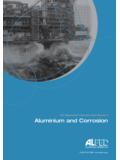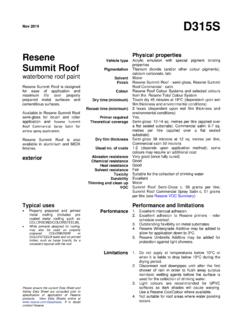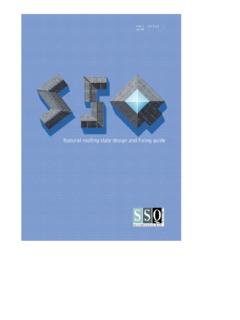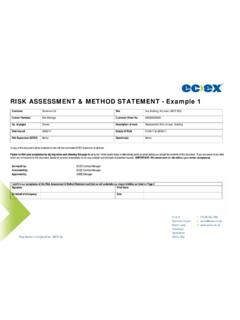Transcription of UK Aluminium Industry Fact Sheet 11 Aluminium and Fire
1 UK Aluminium Industry Fact Sheet 11 : Aluminium and Fire1 Aluminium and FireUK Aluminium Industry Fact Sheet 11+44(0)121 601 6363 UK Aluminium Industry Fact Sheet 11 : Aluminium and Fire1 Introduction Aluminium and its alloys are the most commonly used non-ferrous metal materials and they find wide application in transport, building, packaging, general and electrical engineering. The excellent physical and mechanical properties of Aluminium alloys lead to their widespread use. The alloys are light but strong and their use in transport saves fuel over the whole of the vehicle lifetime. The alloys can be fabricated or cast by all conventional processes, joined by welding or adhesive bonding and given a variety of surface coatings. These coatings, together with the inherent high degree of resistance to corrosion by the alloys, allow the use of Aluminium components in aggressive environments.
2 Finally, after use even over many years, the Aluminium can be recycled, with a saving of energy of 95% of that required through the primary smelter production of the widespread use of Aluminium alloys in building, transport, home appliances and offshore structures, it is necessary to address the issue of Aluminium and fire and to answer the question, does Aluminium burn? .The answer is, of course, No . Each year hundreds of thousands of tonnes of Aluminium scrap are fed into remelt furnaces and heated up to and beyond the melting point. The Aluminium melts when the temperature exceeds the melting point, it does not burn. If it did, the recycling of Aluminium would not be and following the Falklands conflict between Great Britain and Argentina, several misleading statements appeared in the press, suggesting that Aluminium alloys, used in the superstructure of some of the ships that were sunk, had burned and contributed to the loss of these ships.
3 Of the nine ships sunk in this conflict, only three had Aluminium superstructures. All three vessels had steel hulls and in each case the damage inflicted suggested that these vessels would have sunk regardless of the materials of the superstructure. In no case did Aluminium burn. HMS Sheffield, the first British destroyer to be sunk, was widely reported to have an Aluminium superstructure. This was, in fact, an all-steel ship with a steel hull and a steel superstructure. The Defence White Paper published on 14 December 1982 concluded, there is no evidence that Aluminium has contributed to the loss of any vessel . Similar conclusions were reached by the Ministry of Defence Working Party convened to review ship design. The Chairman of that Working Party was reported in the Financial Times, 24 December 1982, I am not aware of any evidence to suggest that any ship was lost because of the use of Aluminium in its construction, nor was there any evidence that Aluminium or Aluminium alloys had burned or suffered from a series of small explosions.
4 Aluminium , like any other material, has advantages and disadvantages in any given set of circumstances. Where the balance is in favour, Aluminium should be used in warships or elsewhere. In fire tests on Aluminium materials, when the temperature exceeds the melting point, in the range 600-660 C, the Aluminium surface exposed to the fire can be seen to melt, but it does not burn. At the end of the fire test, the metal remains as a resolidified in the form of finely divided powder or flake oxidises exothermically, but this is a very special case because of the very large surface-area-to-weight ratio. Aluminium then behaves in a similar way to other finely divided materials such as iron and titanium, tea, flour and coal, all of which will also readily oxidise exothermically in the powder in a FireIf Aluminium is involved in a fire and the temperature rises to above its melting point, the metal begins to melt.
5 The melting point of a metal, like its density, strength, or corrosion resistance, is a characteristic which can be measured and used to design the most effective component for any particular thermal conductivity of Aluminium is around four times that of steel and its specific heat twice that of steel. This means that heat is conducted away faster and a greater heat input is necessary to bring the same mass of Aluminium to a given temperature, compared with steel. Where an Aluminium structure is exposed to the heat of a fire, the relatively high thermal conductivity enables the heat to be rapidly conducted away from the exposed area. This helps to reduce hot spots where significant localised property loss could occur, so extending the serviceability period. It will, however, cause the temperature to rise elsewhere.
6 The extent of dissipation of heat elsewhere in the structure will depend on the degree of thermal insulation provided to the Aluminium elsewhere in the structure, necessary to provide fire protection in that area. The high reflectivity of weathered UK Aluminium Industry Fact Sheet 11 : Aluminium and Fire2aluminium is 80% to 90%, compared with 5% for painted steel and 25% for stainless steel. This is of considerable benefit and will assist in prolonging endurance of an Aluminium structure in a attached photograph is a good example of the behaviour of Aluminium in the massive form in a fire. A car, with Aluminium alloy wheels, was caught in a forest fire that swept over the car and moved on. Afterwards it was found that the Aluminium wheels had melted, molten Aluminium had run off and collected in a pool of metal which solidified as the fire moved on and the temperature fell.
7 The Aluminium had not burnt. Aluminium in BuildingAluminium alloy components are widely used in building as cladding and roofing materials, windows and doors. As defined by BS 476: Part 4 and the 1974 SOLAS Convention (as amended) Aluminium alloys are non-combustible and also provide Class 1 surface spread of flame to BS 476: Part 7. In addition, BS 476: Part 3 covers external fire exposure roof tests and the classifications laid down in the standard range from AA to DD. The first letter refers to the fire penetration performance and the second letter to the surface spread of flame. Aluminium and its alloys are rated AA, the highest possible under this classification system. Materials are also tested for fire propagation performance to BS 476: Part 6 (1989) and coating systems are taken into account.
8 Aluminium achieves excellent ratings under this principal methods of fire protection are employed, using fire resistant insulating layers protecting an underlying Aluminium component. Examples have used ceramic fibre, intumescent coatings applied to the Aluminium element or composite systems with Aluminium external skins. The latter have been demonstrated to be applicable both as load-bearing elements and as add-on panel systems. The Aluminium skin on the exposed fire side of the system is sacrificial and melts, revealing a supported fire insulation material which provides the required period of fire performance and protects the remaining Aluminium elements of the system. A small increase in insulation thickness is usually required to take account of the lower maximum working temperature limit of Aluminium compared to steel.
9 The use of radiation shielding around structures such as stair towers and walkways can provide protection, not only to personnel during a fire but prevent the temperature of the Aluminium structure exceeding the working limits during the design time with all metallic materials, as the temperature increases the strength of Aluminium alloys is reduced at a rate dependent on the alloy, The structural Aluminium alloys have useful maximum working temperature limits that range from 200 to 250 C. Above this temperature the strength is significantly in Marine and Offshore ApplicationsAluminium alloys, particularly the Aluminium -magnesium alloys, have been used since the 1930s in many marine applications. In offshore structures Aluminium alloys are used in many applications such as helicopter landing decks, stairs and walkways, link bridges, housings for electrical equipment and even complete living quarter modules.
10 Considerable cost savings can accrue by the use of Aluminium without any increased fire risk. The use of Aluminium also keeps the total weight down and keeps the centre of gravity as low as information on Fire Resistance Testing we suggest contacting information about Aluminium and Aluminium alloys, their production, fabrication and end use can be obtained from:(1) European Aluminium Association in (2) International Aluminium Institute in London


